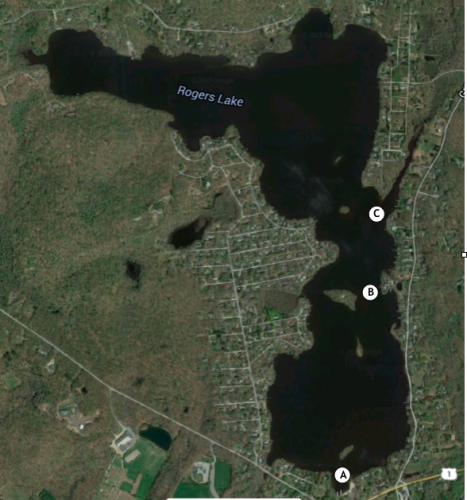
The Old Lyme Conservation Commission regards Rogers Lake as one of the town’s most valuable resources both for its recreational values and for its value as a source for two of the three main aquifers in Old Lyme. This is particularly important at a time when the Rogers Lake Authority plans to apply the herbicide Clipper to large areas of the lake for the very first time.
The Conservation Commission has asked us to publish the 2015 Rogers Lake Long-term Plan:
- Reduce the presence of waterfowl around the lake … 40 geese x 3 pounds per day x 365 days = 43,800 pounds of fertilizer per year
- Reduce the septic system pump-out frequency to three years and include Lyme lake residents in the program. Consider a local sewer system for Old Lyme’s lake residents.
- Encourage the Inland Wetlands Commissions of Lyme and Old Lyme to establish a monitoring system to assure that state law restricting phosphate in lawn fertilizer around water bodies is enforced.
- Greatly increase the use of benthic mats, including use of large mats to cover the worst patches of invasive weeds, especially in shallow water motorboat channels (Figure 1).
- Establish silt ponds at the mouths of the five largest streams feeding Rogers Lake and maintain them every year by removing the nutrient rich sediment and sell it.
- Plan a major fall drawdown (six feet) and plan to deepen boat channels and the worst areas of weed infestation. Establish dewatering areas. Sell the dredged sediment to pay for the operation. Bring in the Connecticut Water Company to provide a local water company to provide water for shallow well owners, permitting major draw-downs and ensuring year round potable water for lake residents.
- Establish special zoning regulations for the 500 acre drainage area on the southeast side of the lake to reduce nutrient runoff. Re-engineer the dam at Ogle Pond so that it can control 3 – 5 inch rain events and prevent flooding of Boston Post Road and Grassy Hill Road.
- Assess the area to the north of the lake for nutrients entering the lake during major rain events. Take steps to reduce this source of nutrients using dams and silt ponds.
- Create an email database for all residents of the Rogers Lake basin in order to keep the residents informed and to permit them to play an active role in lake management.
- Redevelop Hains Park, including the new boathouse project, community room, pavilion, swimming area and appropriate parking to help integrate and invest the townspeople in the life and affairs of the lake community.
- Continue an invasive plant education and monitoring program at the State boat launch to help prevent the introduction of additional invasive species into the lake.
- Seal lake bottom sediment in key areas with alum to prevent the release of phosphorus each time the lake becomes anoxic (usually in Autumn). Even small increases in the levels of phosphorus result in greatly increased weed growth.
- Establish a long term plan to dredge the lake. Establish dewatering locations around the lake and establish a specific location nearby to deposit the spoils. Small quantities of material can be annually dredged from the lake without undergoing the extensive and expensive state and federal permitting process. The Commission suggests that the town take advantage of this opportunity to target specific areas on the lake (See map of Rogers Lake above).